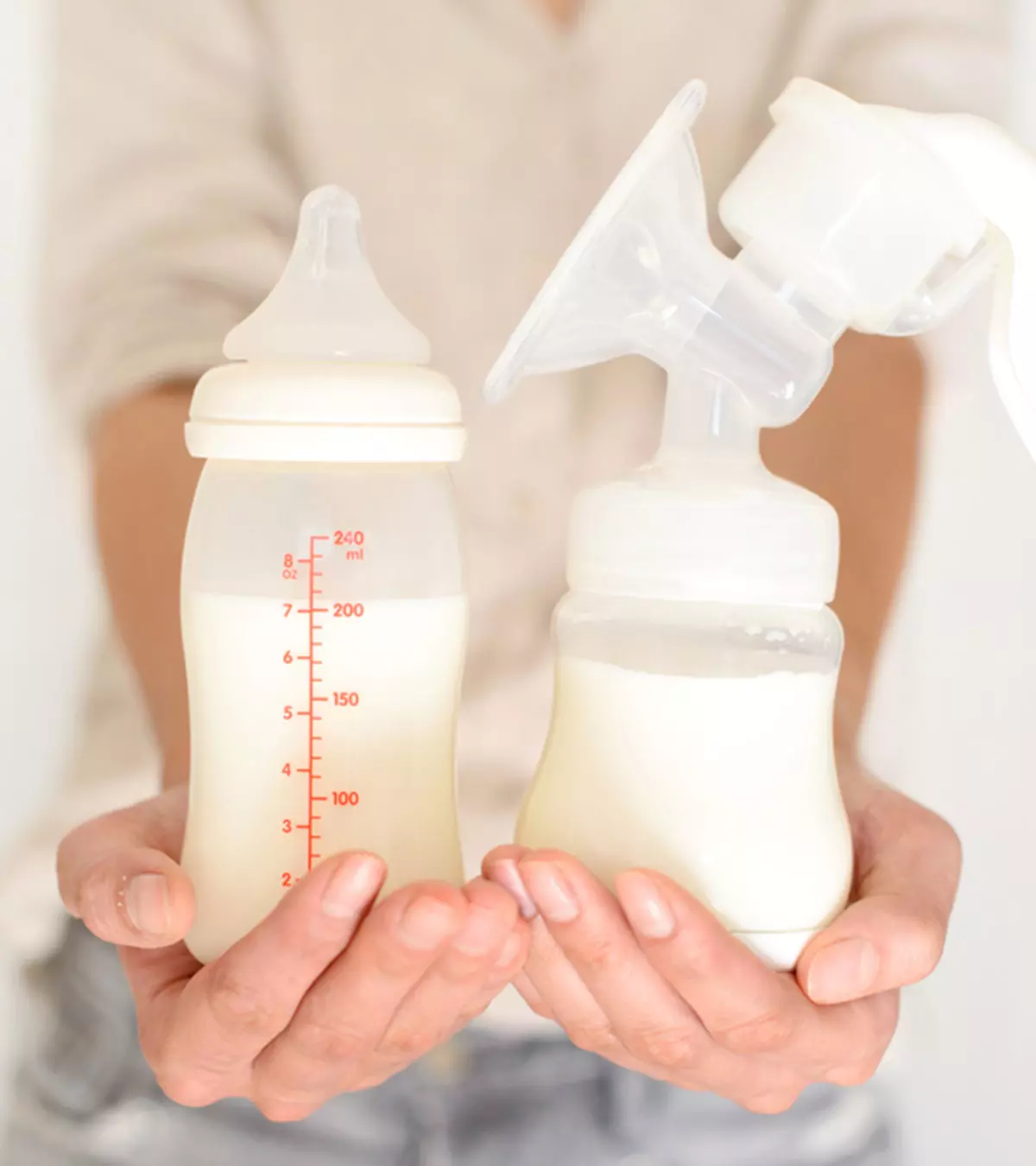
Image: Shutterstock

Comfort nursing for babies is a term for the practice of breastfeeding for reasons other than satisfying the baby’s hunger or thirst. While the primary purpose of breastfeeding is to provide nourishment to an infant, some babies suckle to self-soothe. It is called “comfort-nursing” because it calms the baby down.
A mother may comfort nurse to soothe an upset baby or calm them down when they are cranky or unwell. Comfort nursing provides the same benefits as those from skin-to-skin contact during nursing. Read the post to know more about the benefits and techniques of comfort nursing for babies.
Key Pointers
- Babies may seek comfort nursing when encountering stressful situations, such as pain, illness, or anxiety.
- Comfort nursing is a type of flutter sucking in which the infant sucks at the breast for comfort rather than nutrition.
- The psychological advantages of comfort breastfeeding are generally ascribed to skin-to-skin contact.
- If you see that your baby is not meeting developmental milestones or regressing, consider stopping comfort breastfeeding.
Is It Normal For Babies To Feed For Comfort?

Yes, it is normal for infants and toddlers to breastfeed for comfort. According to the American Academy of Pediatrics, nursing provides closeness to the mother. This maternal physical and emotional connection provides psychological benefits, leading to mental calmness in babies (1). It is why babies may mostly seek comfort nursing in stressful situations, such as when experiencing pain, illness, or fear.
How To Tell If A Baby Is Comfort Nursing?

Babies usually seek comfort nursing at timings beyond their usual breastfeeding sessions. Your baby is likely to reach out for comfort nursing right after a stressful situation, such as after an accidental fall, when scared by something, or when experiencing symptoms of an illness. They may also demand comfort nursing before bedtime or naptime.
During comfort nursing, the baby is less likely to suck strongly. It is also common to see the baby fall asleep while breastfeeding while comfort nursing. A comfort-nursing baby’s latch could also be removed easily. Therefore, the quantity of milk ingested during comfort nursing is very little to provide any nourishment.
 Do remember
Do rememberAre Flutter Sucking And Comfort Sucking Similar?
Flutter sucking is defined as non-nutritive sucking, where the baby is suckling at the breast but not for nourishment (2). A baby may have a weak sucking action or poor latchiThe way a baby adheres to the nipple of the mother while breastfeeding while flutter sucking. Therefore, comfort sucking is a type of flutter sucking, although it is not the only type of flutter sucking.
There could be several other reasons for flutter sucking, such as low milk supply, poor let-down reflex, or infantile orofacial problemsiRefers to problems with the mouth and the face in infants . Some babies may also flutter suck when approaching the end of an infant feeding session.
A baby who requires comfort nursing may do so without interference to their breastfeeding sessions since comfort nursing occurs beyond breastfeeding to satisfy hunger. However, some infants may display flutter sucking even during regular breastfeeding sessions, causing nutrition issues. If your baby tends to show flutter sucking often, speak to a pediatrician or a certified lactation consultant.
What Are The Benefits Of Comfort Nursing For Babies?
The breastfeeding benefits of comfort nursing are often psychological because it is breastfeeding for reasons beyond feeding. Also, many benefits could be attributed to skin-to-skin contact.
Comfort nursing may provide the following benefits to the baby.
- Boosts overall infant development: Skin-to-skin contact while comfort nursing could benefit baby’s mental and physical health (3). It may reduce crying, improve body temperature maintenance, stabilize heart rate and breathing, and benefit immunity.

- Enables better infant sleep: A cranky baby could find it easier to fall asleep after comfort nursing. Adequate sleep is essential for an infant’s health and growth.
- Reduces stress hormones: Skin-to-skin contact with the mother could reduce the baby’s cortisol, the stress hormone (4). It could be particularly helpful in cases when the baby desires comfort nursing due to fear or anxiety.
- Helps in parent-baby bonding: Experts state that infants grow and learn better when they have an emotional attachment with their parents (1). Comfort nursing could provide the mother and baby an opportunity to bond, playing a significant role in parenting and newborn care and enriching your motherhood journey.
Besides these benefits, comfort nursing could improve the mother’s let-down reflex due to the baby’s sucking (5). The sucking action stimulates maternal prolactiniA hormone produced by the pituitary gland which causes the breasts to grow, develop and produce milk and oxytociniA natural hormone that manages male and female reproductive systems, sexual arousal, childbirth, lactation, and human behavior hormones, leading to better milk supply and let-down.
Can Comfort Nursing Be A Problem?

There is no evidence that comfort nursing could lead to problems. Many mothers fear that their baby may become clingier or require frequent comfort nursing to fall asleep. However, experts state that babies who indulge in comfort nursing could be no different in terms of clinginess than other infants.
According to UNICEF, each baby is different, and some babies could be clingy irrespective of whether they are nursed or not (6). Many experts consider it a myth that breastfed babies tend to be clingier since they need nursing to comfort themselves (7). Therefore, you may continue comfort nursing on demand without being concerned about possible problems.
 Point to consider
Point to considerHow To Stop Baby From Comfort Nursing?
There is no need to stop comfort nursing if your baby is feeding adequately, growing healthily, and shows no sign of developmental regression. As the baby grows older, they are likely to discover other ways to self-soothe. Most babies stop comfort nursing by themselves as they approach toddlerhood.
You may consider stopping comfort nursing if the baby:
- Comfort-feeds instead of feeding during a regular breastfeeding session
- Prefers comfort nursing over breastfeeding
- Displays poor growth
- Seems to show more flutter sucking than breastfeeding
- Has problems with latching
- Does not seem to achieve developmental milestones or displays a regression
Several underlying factors or problems could lead to these scenarios. Note any other signs in the baby and consult a pediatrician. You may discuss with the doctor if you may continue comfort nursing.
Comfort Nursing For Soothing
Choose a one-piece pacifier that you may offer the baby during bedtime, naptime, and whenever they appear fussy as comfort measures. Offer a pacifier only after breastfeeding is established, which is after the baby is four weeks old. A pacifier could help the baby dissociate comfort nursing with sleep, nurturing, and self-soothing. Most children stop using a pacifier between the ages of two and four years.
Frequently Asked Questions
1. Do I need to burp the baby after comfort nursing?
Be it comfort nursing or breastfeeding for nutrition, burping the baby is needed to release the air swallowed by the baby when nursing (8). However, if your breastfed baby looks comfortable, burping is not required.
2. Can comfort nursing lead to overfeeding?
No, neither breastfeeding on demand to satisfy hunger nor infant comfort nursing can lead to overfeeding in a breastfed baby (9).
3. Does the baby get milk when comfort nursing?
Yes, even if it is for providing comfort and calming the baby, they will get breast milk when comfort nursing.
4. What should I do if my baby refuses comfort nursing?
If your baby refuses to nurse for comfort, you can try to change positions, create a calm environment, or offer skin-to-skin contact to help them relax. Sometimes, babies seek comfort without wanting to nurse. In these cases, you may offer a pacifier, a soft toy, or simply cuddle them. If your baby refuses to breastfeed entirely or you’re worried, consult a pediatrician or lactation consultant for support.
Comfort nursing for babies is a common occurrence during infancy and not something you should be concerned about. It benefits the baby psychologically more than physically by reducing their stress hormones and inducing better sleep. It is recommended that you should not discourage your infant from comfort nursing because it has no relation to clinginess or other developmental consequences. Enjoy this phase of motherhood with your baby and treasure the mother-baby relationship that is strengthened by skin-to-skin contact when nursing.
Infographic title: Sucking Patterns In Babies
Since comfort nursing is not done to satisfy hunger, mothers should pay close attention to their babies’ regular breastfeeding sessions to ensure they are getting enough nutrition. A full-term baby displays a definite sucking pattern that moves through three stages. This infographic will let you know about them.
Some thing wrong with infographic shortcode. please verify shortcode syntax
Illustration: Comfort Nursing: Meaning Benefits And Tips To Stop It

Image: Stable Diffusion/MomJunction Design Team
With the help of this video, you can master the art of weaning while ensuring your baby’s tranquil sleep. A plethora of tips awaits in this comprehensive video guide for you.
References
1. Psychological Benefits of Breastfeeding; American Academy of Pediatrics
2. Breastfeeding Module; Florida Nutrition Training Guide; Georgia Department of Public Health
3. JoLyn Seitz, The importance of skin-to-skin with baby after delivery; Sanford Health
4. Skin-to-skin contact; UNICEF
5. Let-down reflex; HealthDirect
6. Busted: 14 myths about breastfeeding; UNICEF
7. Tessa Zevallos, Darle El Pecho: A Qualitative Exploration of Mexican Immigrant Mothers’ Experience With Breastfeeding; Illinois State University
8 Burping a Baby; Kaiser Permanente
9 Your breastfeeding questions answered; NHS
Community Experiences
Join the conversation and become a part of our nurturing community! Share your stories, experiences, and insights to connect with fellow parents.
Read full bio of Arushi Agrawal
Read full bio of shreeja pillai
Read full bio of Rohit Garoo
Read full bio of Anindita Ghatak

















